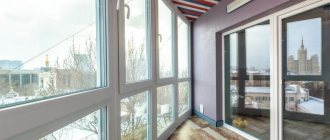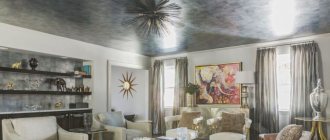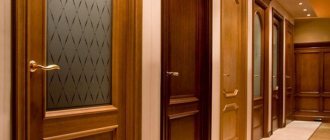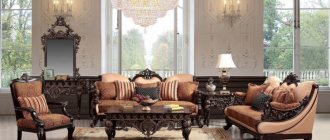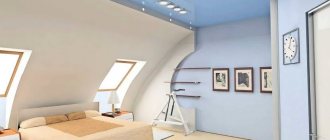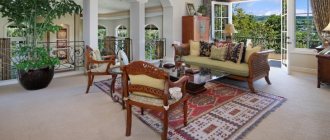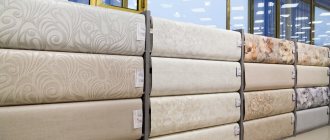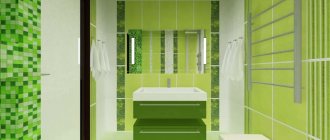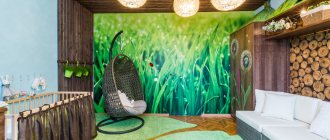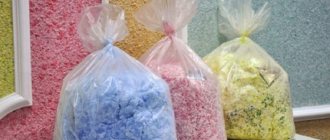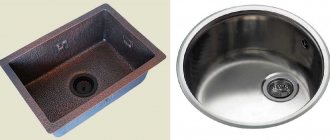general characteristics
What are the main pros and cons of wallpaper for painting? Decorating walls with wallpaper is the shortest way to obtain the final result with the least amount of time and nerves spent.
This is the advantage of wallpaper for painting over traditional painting work. Wallpaper does not require special preparation of the wall surface - it is enough to remove serious damage, and minor damage can be hidden under the canvas, especially under the textured one.
- High-quality coatings intended for painting have a base made of non-woven or fiberglass, which means that they additionally insulate and strengthen the wall.
- The material itself has a fairly long service life, which significantly increases the time until the next repair; moreover, high-quality finishing material - for example, non-woven wallpaper for painting - can be repainted up to 15 times without visible consequences.
- We are talking only about high-quality material, since simple, cheap, textured paper-based wallpaper completely loses its attractiveness after 3-4 repaintings.
So, the main advantages: Painting wallpaper allows you to give the surface a finished look in the shortest possible time, hide minor wall defects, improve sound insulation and increase the interval between repairs.
Many modern coatings intended for painting contain only natural ingredients - for example, bamboo, reed or even algae, which classifies them as environmentally friendly products.
When purchasing vinyl wallpaper for painting, you should make sure that there is a certificate of conformity - this will guarantee that no foreign odors will appear in the room during operation.
Advantages and disadvantages
Paintable wallpaper, also called structural wallpaper , has positive qualities expressed in the ability to repeatedly change the color of walls in a short time and without significant material costs.
Thanks to the use of such wallpaper, you can quickly and easily provide the room with a fresh and uniquely beautiful appearance.
It should also be remembered that paintable paper wallpaper is a decorative material and is itself a worthy decoration for a stylish interior.
Paintable paper wallpapers do not have a specific pattern, so they are used not only to decorate walls, but also ceilings, which creates a feeling of seamless space in the room.
Painting wallpaper on the walls and ceiling in one color visually provides a uniform and smooth surface.
Paintable paper wallpaper is safe and environmentally friendly .
One of the disadvantages of paintable paper wallpaper is that it can tear, bubble or form wrinkles, so they should be glued with extreme caution and scrupulousness.
Paint selection
To ensure that the environmental component of the house is not compromised after renovation, it is worth purchasing adhesives and paints and varnishes that do not contain toxic chemical components.
Purchasing paint for wallpaper, like purchasing any things, is a responsible process, since the final result directly depends on the quality of the paint and varnish material. Acrylic, water-based or latex paints are considered the most suitable.
You can choose the desired shade or do the tinting yourself. By the way, now many building materials stores have equipment that allows you to mix colors without effort.
Material selection
Wallpaper for painting in the interior can be paper, non-woven or fiberglass. It is clear that each material has its own advantages and disadvantages. The most short-lived will be the paper-based coating, the other two have a decent service life and require better finishing results.
- Regardless of the base, all material intended for painting must be white, without any shades, and can be textured or smooth.
- It is worth purchasing smooth wallpaper for painting if the idea involves some kind of original work - say, creating a painting or pasting a ceiling - and textured surfaces are in no way suitable. In addition to their decorative function, smooth coatings cope well with minor mechanical damage.
- True, if necessary, you will have to purchase additional tools: textured rollers, stencils for printing ornaments, in general, some small things.
- Textured wallpaper also has its positive sides. Their biggest advantage over smooth coatings is that they imitate almost all existing finishing materials.
- There are also textured finishing materials on sale with various original, and therefore unusual, ornaments and patterns that are ideal for adherents of abstract art.
Most often, textured wallpaper is painted in a single color, and for placing any accents, combinations with smooth wallpaper or various color combinations are quite suitable.
There are plenty of examples in photos of wallpaper for painting on the Internet.
Criterias of choice
It is necessary to purchase finishing, taking into account not only the advantages and disadvantages of a specific area, but also the entire house. For a small apartment, it is recommended to choose wallpaper for the hallway according to tone, since there are no windows in the room. The decor and decoration of the front walls should be harmoniously combined with the overall interior.
When choosing, it is also recommended to pay attention to the fact that the wallpaper:
- had good air permeability, eliminating the proliferation of pathogenic microorganisms, the formation of fungi and mold;
- did not lose their original appearance under the influence of abrasion and impact loads;
- did not accumulate dust and did not cause an allergic reaction among residents of the apartment.
Since a lot of dust and dirt from the street settles on the surface of the corridor walls, when choosing wallpaper it is necessary to give preference to options that provide for periodic wet cleaning.
For the hallway, wallpaper that imitates plaster, stone, brick or tile is most often used. In the photo of wallpaper for the hallway you can see what a specially selected finishing option looks like, matching the interior of the room.
Nuances of work
It is worth following the instructions on how to paint wallpaper. Before applying the coating intended for painting, it is necessary to prepare the wall surface.
The advantage of this finishing material is that no special processing is required:
- It is enough to simply correct gross defects in the plaster and apply a layer of primer to it.
- If you use liquid wallpaper, this procedure is greatly simplified.
- It is advisable to apply the adhesive composition to the wall - this way the wallpaper will dry faster, and the glue consumption will also be significantly reduced.
- You should use paint designed specifically for this type of material, as it practically does not clog the texture.
- This will allow you to simply wash and repaint the wall if necessary. You can apply paint in any way. But many people prefer to do it with a roller.
The coating for painting is applied using the same technology as in the case of conventional wallpaper: The air is also expelled from under the pasted canvas with a roller; in the same way, windows and doors in the room should not be opened until the coating has completely dried.
And finally, one very wise piece of advice:
- When decorating a children's room, this type of finishing material can greatly facilitate the final stage of finishing.
- It is enough to paste the wallpaper on the wall and then give the paint to the children - exclusivity is one hundred percent guaranteed.
True, then the painters and the floor will have to be scrubbed of paint, but this is not a problem either: It is enough to cover the floors with film, and dress the children in professional painter suits.
But there will be no limit to delight and joy - you just have to remember Tom Sawyer.
Vinyl
The finishing material has a porous surface and consists of a top vinyl layer and a backing, which can be paper or non-woven. Such wallpaper is quite expensive, and the high cost is not justified, since when combined with wallpaper glue, the chemical material can emit formaldehyde vapors for 4 years.
Vinyl wallpaper on a paper basis has low breathability and can cause the formation of a damp environment, as well as the appearance of fungi and pathogenic microorganisms.
